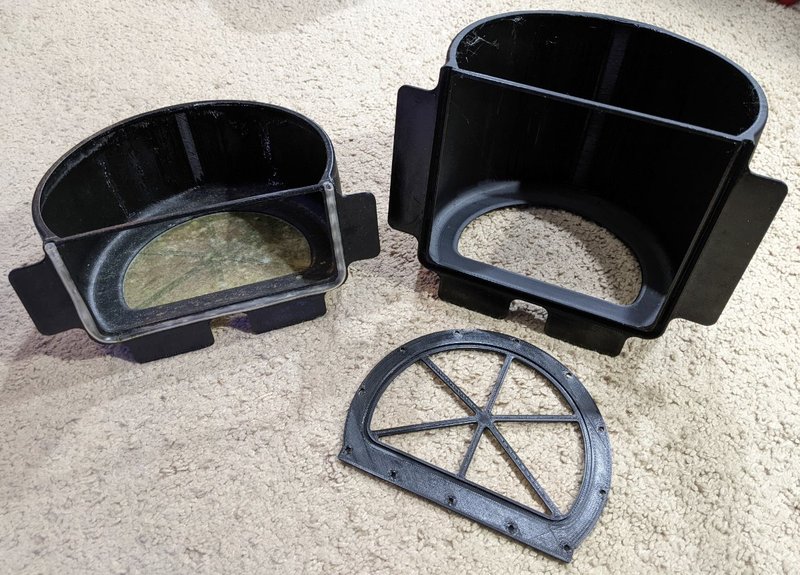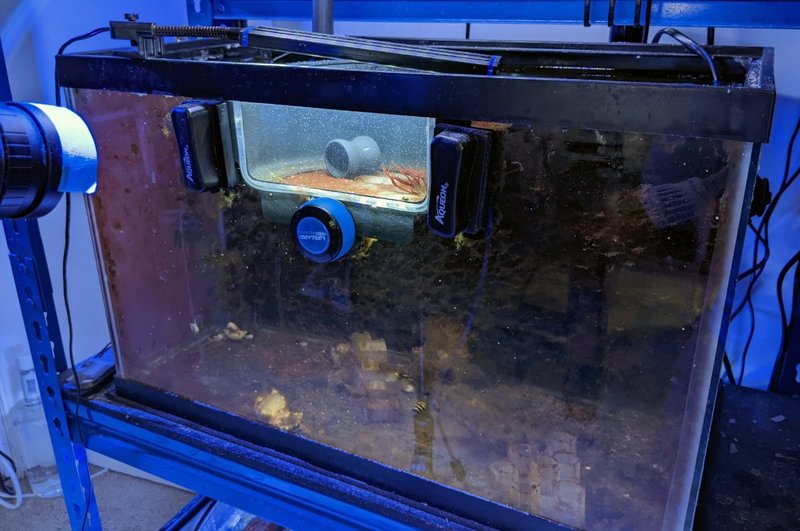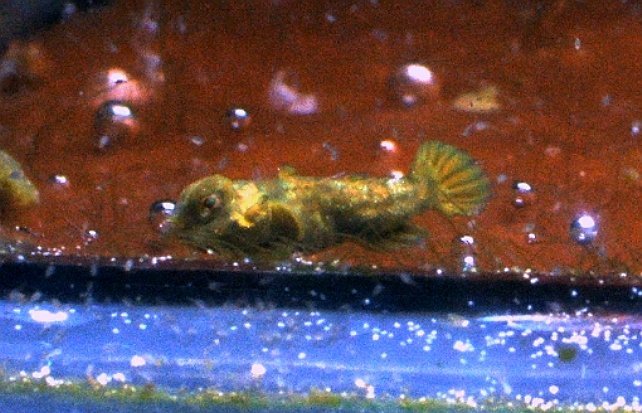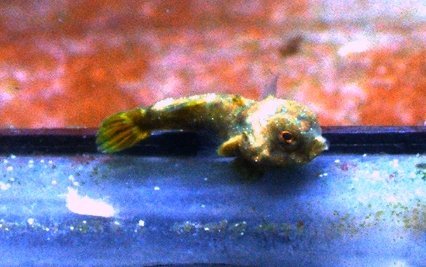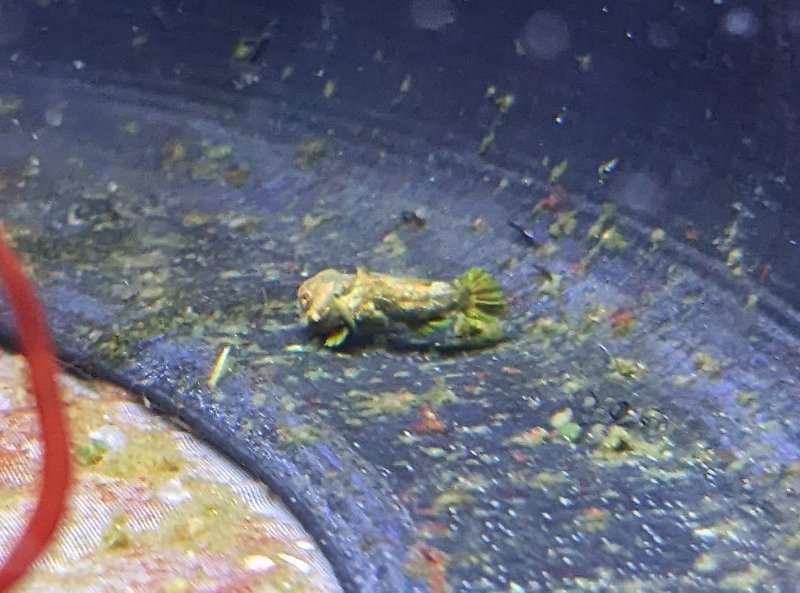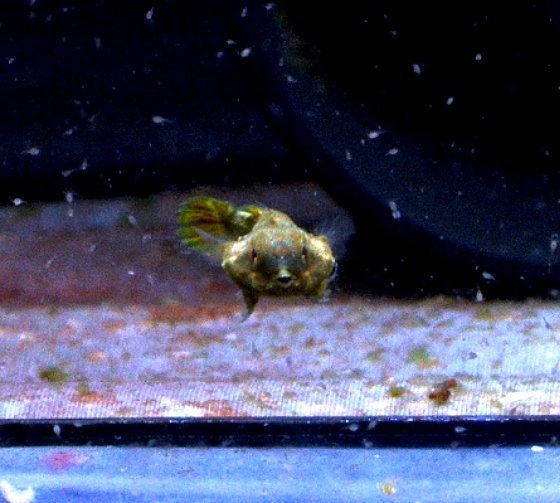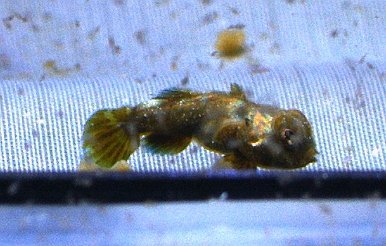-
Posts
748 -
Joined
-
Last visited
Content Type
Profiles
Forums
Gallery
Events
Store
Everything posted by DaJMasta
-
I would contact Red Sea, they do sell replacement parts for their stuff. If it looks like a standard part (like a standard bulkhead) you likely could get something branded differently, but IIRC, they use metric fittings, so it may be difficult to source the exact right size in the US.
-
They have figured out how, and tank bred tanks are available (usually pretty small), but as I understand, it took years of attempts with a dedicated team to get consistent, albeit very low survival rate, results, and then some years more of adjusting the process to be commercially viable. I think they have a pretty specific diet as larvae but also require a fair amount of flow, which can be difficult to do without bladed pumps, but maybe there are some actual papers out on it now. Prices also went up across the board for covid (fewer flights meant MUCH more expensive air freight rates), and they both haven't recovered a lot and probably aren't likely to recover a lot more soon.
-
-
Probably possible with reasonable filtration, you're on the high side for fish load but not to a crazy degree, and neither consideration would be one to bully the others or occupy the same spaces, generally. I think the firefish would probably be the worse choice given the tank size, as they'd be swimming pretty much all the time, and it would also require a top (though I would use a top on the tank by default, at this point, things jump more easily than you'd expect when spooked even if not jumpers). A watchman goby, especially a small one, wouldn't swim nearly as much and would basically just be out of the way of everything else. Also the potential for a pistol shrimp partner, which is always neat.
-
I've been feeding the tank twice a day with frozen, though for the first few months of having two mandarins, I was feeding once a day. I've got two mandarins and a ruby red dragonet in an e170 (~45g AIO), so I don't think pods are a huge part of their diet, even though I add some as residual from the farm a few times a week. I think that they have a shorter digestive tract is a fact, but I don't think that means they must constantly eat - they do sleep at night, after all, and it's common to see the males (and sometimes a female) sort of protecting their territory in the evening (going after their reflection in the glass) without eating while doing it. I think the necessity to continuously eat is more just the size of the prey - if they're only getting copepods, it could easily take several hundred or a few thousand to equal the same amount of nutrition as a single small mysis shrimp, so unless they get larger worms or amphipods, it's likely they have to spend most of their waking hours grazing just to get enough food. As for the setup, it's probably more basic than you envision, but I can run it down at least: They were raised until settlement in a 10 gallon brute trashcan, about 80-85% full with saltwater. I used three small always on heaters (7.5W each, IIRC) for heat and a not-reef-brightness LED light in the center over it. I also had an airstone dropped on an airline in the center of the tank, set fairly low for a slow circulation in the tub. After settling, I transferred the then two juveniles to a 10 gallon tank plumbed into a 30 gallon system and put them in a 3d printed tray I designed for some earlier spawn work. It's basically a cylinder with fine mesh on the bottom (printed parts sandwich the mesh and it's glued into place), with the side sliced off and little plastic paddles made so you can use aquarium magnets to hold it on to the side of the tank and have a peak inside. Because the seal along the glass needed to be tight, I left a semicircular cutout along the edge and put in a length of silicone airline tubing to use as a rubber gasket. The smaller one is a complete tray, the bigger one is a stretched version that's newly printed and not yet assembled. This is what the 10g with the little girl looks like today (that's her in the bottom right) with an extra light over it and the lens of the camera on the left. The tank needs an algae magnet clean which it shall be getting shortly. And one of the pictures captured from that setup of her 15 weeks post hatch: A little greener by eye, a little more time spend on the side walls and on the little piece of lock line instead of just puttering around the bottom, but basically the same look/activity as last week and little farther along with coloration and size. Oh and the mesh box used for teaching the adults to eat prepared food is just the standard Petco one for $10, nothing particularly fancy, I like to use an algae magnet inside it to keep it up on the glass way more reliably than the single suction cup.
-
Where were the corals in the scape? From the extension of the zoas, it's probably not so bright in the lower half, though that goni in the center looks pretty happy. Parameters wise it seems generally good, a little high on the magnesium and calcium side, but not problematically so, and the goni, fungia, candy cane, etc. are stony corals that seem to be doing well, so I don't think it's a skeleton-forming-chemistry thing. My guess is light intensity and flow. A breeze on the corals you have will be on the low side for an acro, and there are spots in the scape that probably get a lot less than that. and with the light situation maybe the best spots would be sort of centered under each light, at least mid tank high, otherwise if the lights are down at all, you could likely increase them slowly (less than a percent a day) and not %$#* off too much of what you've got, and then get something sps and give it a try in a higher light and flow area.
-
I've been meaning to properly write it up/describe it, but it's basically like this: The goal is to get them eating prepared foods as soon as they are fed, because they are not particularly fast eaters and will be out-competed to find the chunks by other fish unless they know to eat it as soon as it's offered. And while they seem to universally like it, they are visual hunters (and ones with a high miss rate), and they simply don't recognize most prepared foods as being foods. So my method is to put them in a mesh sided breeder box in the tank until they start accepting the prepared foods. By keeping them in a confined space, their random picking around at things will be much, much more likely to accidentally eat a morsel of prepared food, and after a few of those, they'll start being able to recognize what it looks like. Keeping them in a space where you can directly interact with them also makes them less likely to just run off when feeding time comes because you showed up at the tank, and the fine mesh sides keep the food in there. So they go in the mesh box, they get fed twice a day with frozen of different types, and each morning I vacuum out the old food with a baster. Typically, you will see some food disappearing in the first few days, but they won't actually be going after it as soon as it's offered for a couple of weeks - usually 2-3 weeks is what it takes them for me. It seems that whole-organism types of food get accepted sooner (probably because it looks like a natural food), and I don't see any preference to the very small ones (like PE calanus). I think it's better to get them onto larger foods anyways (and they can eat bigger pieces than it looks), because that means if they can slurp up just a few, they get a good amount of nutrition out of it. I've had best (fastest) acceptance with frozen bloodworms, followed by mysis and krill chunks (though these are large). PE sized ones are alright for grown mandarins, but I would stick to hikari or smaller sizes for smaller mandarins or with other small dragonets. The first thing one of mine ate in training was the head of a krill from a mixed, chopped blend, and while it got it in, it spent a few minutes "sneezing" and whipping around its tail to try to get it all the way down. I've also seen ruby red dragonets swallow bloodworms 2/3 of their own length, though it did take repeated attempts (which looks hilarious as the worm goes in and out of their mouth). Especially if the mandarin looks thin, I'd recommend feeding pods directly for the first couple of days, but it may be that feeding pods alongside the frozen foods actually slows the uptake of frozen foods. Don't consider them done with training until they will accept more than one kind of food shortly after feeding, and it's worth leaving them in the box a little longer if they're eating readily but still look thin - it will take a lot more effort to swim in the open waters of the tank, and they will be stressed somewhat from the new introductions, plus it tends to be that they take a few days to start recognizing when they're being fed prepared foods again, even if you use the same tools. Also worth mentioning that my flow is entirely off for feedings, and I keep it off for 5-10 minutes. They are not fast enough swimmers to catch chunks of food that are drifting by (I've seen them chase and not keep up with falling frozen foods...), so some time for the food to be settled probably helps a lot with how much they can eat. I think so far I've trained 4 mandarins and 3 ruby red dragonets this way successfully, though there has been small tweaks and experimentation each time.
-
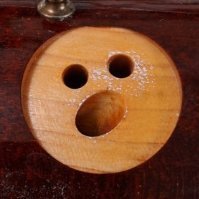
Long, thin worms/tentacles reaching out of snail shell?
DaJMasta replied to Kathryn Lawson's topic in New to the Hobby
Yeah, spaghetti worms, but for whatever reason the ones in my tank seem to be red, mostly. The tentacles look like individual worms, but they meet up in a base that's thicker and less worm like. It may be worth noting if you want to try to grow them for whatever reason - they seem to like empty shells. I pulled an old shell out of my tank yesterday and managed to pour out like three of them after it had been sitting on the sandbed for months. -
If you want a clear solid top, go with polycarbonate, acrylic will slowly warp when installed and won't be nearly as long lasting. Some of the custom builders will include cutouts for plumbing or a port hole for feeding. That said, if you want a top for your tank, I'd go with clear mesh. I've got them over my tanks and have been happy with them - space for gas exchange and no extra heat trapped, no algae growing on the underside, no issues with salt creep, and still keeps the fish in when sized right.
-
I think even with the water sample and the interior swab, stuff gets missed. My test a few months ago came back negative for cyanobacteria and dinoflagellates.... and I can see them, just neither would live where I swabbed and it was during the day and without stirring things up so presumably they wouldn't be likely to be in the water column.
-
A little update outside of the little one: I got a male mandarin a month or so ago, spent a few weeks training it onto frozen food (I think this one took longer since I also added some pods early on), and introduced him to the tank as I would other fish. In the first few hours, the original female chased him all over, and I ended up pulling him out near exhausted against the overflow and put him in one the larval rearing tanks. He didn't seem hurt, just tired, so I gave him a week to eat and recover. Yesterday, I moved him back to the main tank, but left him in an acrylic trap to keep them separated. The female, who usually runs from me and hides in the back, was out and active and clearly aggressive for a bit, then active and interested for a few more hours, and gradually started acting normal, just noticing him when passing by. He also seemed to get a little more confident and not immediately just fleeing when she acted aggressive. Today, they were acting reasonable to each other, so I opened the door to the trap and he eventually swam out. They had a few moments that saw both hovering and with fins up, but it seemed no obvious aggression or chasing, and they stuck around each other a decent amount. After lights out, they spawned, and I collected maybe three dozen eggs, though I don't have a rearing tank that's empty, so they went in with some peppermint shrimp (another recent project in progress). It may be a few weeks before I can do a proper batch again for a second attempt, but I'm very happy to have a spawning pair again.
-
I definitely agree that the sun could be contributing (and the sun is much more intense than our lighting, generally), but bare bottom tanks without established rock are always going to have prolonged ugly stages, too. If you have space in the sump, I'd consider adding some ceramic media or a refugium with deep sand - the surface area of the sand that isn't in your system is very high and the stuff that lives in it is not necessarily the same as the rock, so having some (or just the extra surface area) would probably be a benefit in the long term. I'd agree that the phosphate is on the higher side too, it could certainly be from feeding (frozen seems to raise phosphate proportionally higher than nitrate, from my experience and what I've read), but it's known that some dead rock can leech some amount out of it as well, so you could also try treating with lanthanum chloride or running some GFO for a few weeks or a month and then seeing if it rebounds because of feeding. If you want coralline, any kind of coral frag with some growing could bring it in, a lot of CUC will have it on their shells (do you have any snails/crabs/urchins?), and you can also buy it in a bottle - I've seen pink and purple bottles sold, and they do actually contain active algae spores. While it's not the best look, especially without coral it's not doing any harm, so you have plenty of time to try and determine the cause, and even if you don't, the time will probably help solve it eventually.
-
Flow, temperature, or lighting if inadequate could cause issues even when water chemistry is normal. It's also worth double checking your water with another set of kits (maybe get a LFS to check too), it's possible for kit reagents to go bad and read off of what they should, or your refractometer to drift away from where it should be and leave you with the wrong salinity. Do you have Acros, or other SPS? There are some leather corals that release chemicals into the water that can poison acropora.
-
No judgement, I've seen 2ppm on my Salifert kit The SPS are generally fine with it, presumably they are just used to it, but I do see a bit of loss of coloration near the base of one acro in particular that helps clue me into when to go with the lanthanum chloride (a viable option, but likely would need to be a daily dose to maintain a "regular" level). I'd rather have the nutrients converted into filter feeder food anyways.
-
Hmm, your description of the high phosphates and no nitrates sound somewhat like the way my tank has been running. I've been carbon dosing (vodka) but have been limited on how high I can go with it because of lack of nitrate, even though my phosphate levels are routinely 1ppm or more. Not exactly bacteria dosing, but the carbon dosing is sort of for the same thing (and my aquabiomics test came back pretty well balanced and diverse), so I wonder if I should try dosing some nitrate and increasing the vodka addition (to the tank, I swear!)
-
My main tank also gets noticeable algae on the glass every 3 days maximum and it often takes another day to actually clean it off the glass but thank you!
-
Another mostly normal week, a little new behavior. Her color looks a little darker in person (at a distance) and a little lighter at night while asleep. She's also picked up the behavior the adults have of sort of acting angry/territorial with their reflection in the glass - I wonder if the ~12 week mark is where they'd normally need to be split up if raised in a group of several. In that first month where she had a sibling, they totally ignored each other, but it looks as if she would no longer do so. Not quite to full color yet, and a similar look of bigger-but-hard-to-tell-how-much, so we'll see in another week, when she'll be more than 100 days old!
-
A little update without much more success, but an interesting development, I think. The pair spawned about 2.5 weeks ago (forgot to write down what day, but I think Sunday was 15-17 days post spawn), and since I wanted to catch him early, I put the trap in on Saturday. I saw them hanging around in it on Sunday, missed my first chance, and then saw him spit out two (maybe three), so I shut off the pumps and managed to get two caught with a baster. They went straight down to the substrate and towards a hole in the sand after spit out, and were both alive, but that probably explains where they have been going if he's been spitting them out early. I put them in a mesh box, then managed to catch him a bit later (with a less full looking mouth, but I didn't see him spit any). By the end of the day there were 10 or a dozen in the box, a number of which were alive (at least at some point), and he started eating at night, so I let him out. The ones spit out were all noticeably premature - one was an egg, the others had hatched but were basically a tadpole with a yolk sack (no forking of the tail yet, very little swimming), and it almost seemed as if the yolk could twist at its connection with the body of the fry - probably a very risky thing being outside of their parents' mouth at this point. It also could be that they were not developed enough to pump water over their own gills well, so I don't know how well they could have survived under best case conditions, but the following morning none of them were still living. So they're being fertilized, and they're developing, but it sort of seems like they're being spit out early, and being lost in the process. I don't know what I can do, exactly, and I don't know why he's spitting them out. It could have something to do with my catching him and them sort of remembering and getting agitated from it, but that could be beyond what they readily remember/understand. It could also be some nutrient related thing, but I don't really expect it to be as their diet is still varied and they still eat a lot. There is some chance they're being effected by some environmental factor - I recently found that my refractometer was drifting low and quickly, so I've been under salinity (~32ppt) for a bit now - but I don't know if that would have a significant effect on them. I think I will try the same next spawn cycle, just trying to catch him early and have him spit them out in a mesh box, but maybe I'll try to sort of make an egg tumbler sort of thing - not likely to work well if their connection to their yolk sack is narrow and twistable, but if they just need circulation to keep alive until they can swim themselves, it should do the trick. I know there are seasonal differences in spawn success as well, but as the seasonal changes in the tank aren't huge and the time since the last good spawn is long, so I think it's past that window for a fish that spawns pretty much every month. Time will tell, hopefully.
-

Looking for a good filter feeder supplement...
DaJMasta replied to rrubberbandman's topic in General Discussion
I've been using primarily powders - reef roids, benereef, fritz coral max - and had good luck with the filter feeders until I had a copperband stop by and eat a few of them... I had also been feeding phytoplankton, but I think especially for the larger creatures, you can get by without (and I kept them for half a year or so before starting on the phyto). I've heard good things about oyster feast on the liquid side, but haven't used it myself. Mix them with some tank water and feed the mixture - broadcast is fine for most things, but I've been target feeding my gonis with it a bit and they seem to be better for it. -
Unless you start seeing sort of snotty trails leading up with bubbles in them, I wouldn't confirm dinos, but they can look like that at smaller heights. That said, while dinos were once a big cause for concern, they're now sort of just a nuisance. I've had some small amount in my tank almost since its inception, and just keeping your nitrate and phosphate levels above zero (which is usually what's otherwise best for corals and such) will keep them manageable. Could also be shorter hair algae, sometimes it can look brownish when dying or in drastically different lighting. While I've seen some CUC advertised as predators of them, I don't know how effective they will really be, since if it is dinos, they will grow back within a few days - so a predator of them would have to cover the same spot pretty frequently. Since whatever it is is still on a plug, you could likely pull them out, dip them in something, or scrub them a bit and clean it off pretty well. You'd want to check compatibility with what corals you've got, but a bit of hydrogen peroxide dabbed on the affected areas or a diluted H2O2 dip could likely get it cleaned up.
-
She's 13 weeks/3 months old today, a little bigger (hard to quantify, but he definitely looks bigger somehow), very slightly more colorful, entertaining to watch.... but still not to full coloration. I've read 3 months is about the number, and I've thought it was imminent for weeks now.... we'll see in a week and a half if she's got full color at 100 days.
-
Haha, I'm not even feeding her space every day, there's just a ton of them, I feed it phyto just to keep them nutritious... Between the actual cultures and the larva rearing containers that develop into pod colonies after a week or two of culturing, I have a LOT sometimes.
-
She (the dorsal fin has some pigment and doesn't seem to have a spike but I have no idea if that would be visible by now, so....?) is still growing, getting more colorful, and getting sassier. Here's a video:
-
While possible, I think the fundamental problem in trying to is the difficulty in targeting specific elements for removal. One part of ICP is that it's analyzing the ionized components of the molecules present, so you don't necessarily know the molecular form of what these quantities came from (though you can infer it from knowing the chemical processes that carry it in the water in the first place), and then you need to very specifically target those problematic molecules for removal. Since sorting nanomachines aren't a thing, that could be very selective fine sieving (like an RO membrane with a specific pore size), chemical additives, flocculants, or other methods, and probably several of them to get everything needed out and then remove the residual. What's more, there's a chance that those problematic molecules actually contained the majority of the element you wanted to keep, or that the ones you want to keep are locked up in a molecule that isn't usable by reef creatures. Now the last one is probably least likely given that it's in water, but still, your resulting solution of desirable elements/molecules would then likely not reflect the replenishing needs of your tank, so you'd need still more processing of it until it was in a form you could actually dose. Chemistry is tricky. The right stuff can be right there, but unless you can isolate it and add it in a controlled manner, you're just dumping stuff into your tank you can't really account for and hoping for the best.
-
He's a bit more active this week, scooting around the tank with fewer breaks and seemingly more of a place to go (but he's still surrounded by food and doesn't care in the slightest bit about the piece of locline I put in as a cave.) But is basically doing as before, with slight coloring changes. Most notably, there's a clearly brighter line across his back behind his eyes that seems to be mostly a reflective layer under the skin, and there's a whiteish patch right above the base of the tail that seems to be actually a white color, so he's got two sort of distinct bright spots even from a distance.



